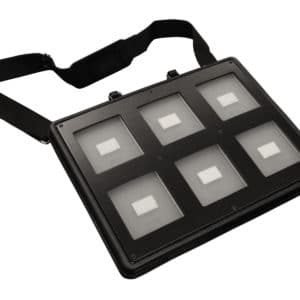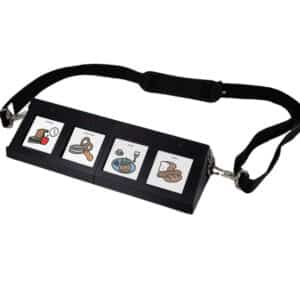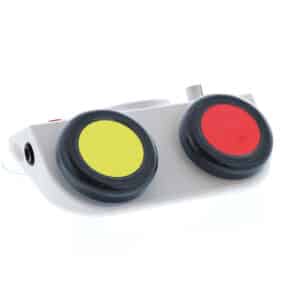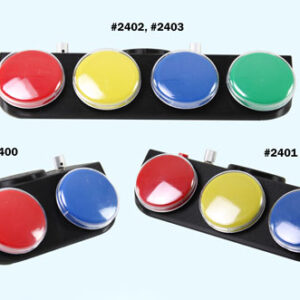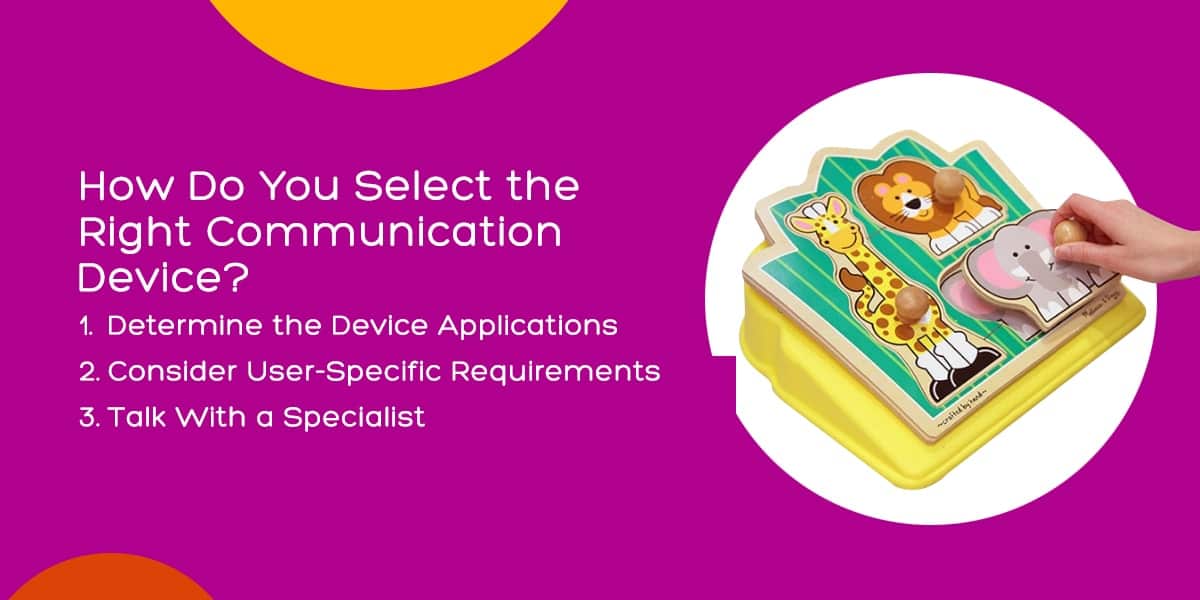Communicators — AAC Devices
Categories
- Accessories
- Communicators — Big and Small Talks
- Communicators — Cheap Talks
- Compartment Communicators
- Icon Holders & Makers
- Language Development
- Mountable Communicators
- Non-Voice Communicators
- Progressive Communication Devices
- Say It Play Its
- Scanning
- Sequencer Communicators
- Simple Communication Devices
- Take & Talk Series
- Talkables
- Visually Impaired
- Wearable Communicators
-
Small Talk SequencerSKU #8151WSmall but mighty, this compact communicator has single, sequential and random message capability. Save with a set of 3. To view accessories for this item click accessories tab below.$179.95 – $485.95
Select options This product has multiple variants. The options may be chosen on the product page
-
Tactile Communicator Say It Play It!SKU #4210The Tactile Communicator Say It Play It packs a lot into one device, acting as both communicator and switch. Press any of the four plates to play a pre-recorded message and simultaneously activate a toy or device.$189.95
Add to cart
-
Tactile Symbol CommunicatorSKU #4040Icons not included! Uniquely designed for those who are blind or dually sensory impaired, this six level communicator with room for 36 six-second messages.$419.95
Add to cart
-
Improved design! All it takes is a gentle touch to activate this sense-ational switch that plays a 20-second long message, as it lights up and vibrates.$199.95
Add to cart
-
Talk 4 w/LevelsSKU #2500BThis ergonomically designed, state-of-the-art 4-message communicator comes in two versions: Basic and Levels. The Basic Talk 4 #4047B plays four 5-second messages. To view accessories for this item click accessories tab below.$299.95
Add to cart
-
Talkable 2 for VISKU #2600Have a heart-to-heart with a little help from our popular Talkable 2, created especially for those with visual impairment. To view accessories for this item click accessories tab below.$169.95
Add to cart
-
Talkable 6 Spinning CommunicatorSKU #2409Communication is right at their fingertips with this spinning version of our most popular communicator. To view accessories for this item click accessories tab below.$249.95
Add to cart
-
Talkables With Built-in Icon HoldersSKU #2400WImproved design! Compact and intuitive, these basic easy talk message communicators come with built-in icon holders and free clear covers. Five models available, from 2 to 48 messages. To view accessories for this item click accessories tab below.$169.95 – $269.95
Select options This product has multiple variants. The options may be chosen on the product page
-
Talking Photo AlbumSKU #9127A wonderful way to facilitate communication and express creativity, this interactive communicator encourages users to tell their stories through photos, icons and drawings.$89.95
Add to cart
-
Textured Tops for Gumball SwitchesSKU #3821Four different textured snap-on tops that can go on our Gumball switches (#782), Small Talks and Talkable communicators.$35.95
Add to cart
-
Totally Tactile CommunicatorSKU #2046Designed especially for the visually impaired user, this communicator features brightly colored plates with raised designs. Features 6 levels for a total of 36 messages and a total record time of 300 seconds, 7 seconds per message.$389.95
Add to cart
-
Twin TalkSKU #1405WEncourage self-expression with this simple yet versatile communicator. To view accessories for this item click accessories tab below.$169.95 – $458.95
Select options This product has multiple variants. The options may be chosen on the product page
Selecting the Right AAC Device
To pick the best adaptive communication device for an individual, consider the following:
1. Determine the Device Applications
Give thought to the product’s day-to-day applications and key objectives and determine what is most important in the device you choose. The size and sensitivity of the device might be important, as well as whether it can easily be mounted to a wheelchair, bed rail, walker or tray.
Communication devices are useful in all sorts of settings, including:
- Classrooms
- Homes
- Therapy
- Public places
2. Consider User-Specific Requirements
Consider the user’s abilities, preferences and developmental goals. Knowing the user’s strengths and weaknesses can help you identify the device that will work best for them and help them reach their potential.
Factors to consider for children and adults include:
- Cognitive level: Communication devices for non-verbal adults and children are available for a wide range of cognitive abilities. Some devices have several graphic symbols with printed words, and others help users communicate a few words.
- Sensory-motor skills: People with sensory-motor restrictions benefit from communicators with larger buttons.
- Vision abilities: People with visual impairment might need high-contrast icons or audio cues to select messages.
In addition to the abilities of each individual user, consider what the user needs to communicate. If they will be answering yes or no questions, a two-message communicator could work. If they are expressing more complex feelings and emotions, then a device with more message capacity is probably in order. When communicating in a public setting, use a wearable device.
3. Consult With Specialists for Personalized Solutions
It’s a good idea to reach out to someone who can offer some additional insight. If you’re trying to decide which communication device is the best fit, consult a speech therapist, occupational therapist, AAC expert or other expert. These professionals will help you find devices that meet the user’s needs.
Enabling Devices works with specialists to ensure you receive a device that is the best fit for the user. Our staff members are also product experts who can help you find the device you’re looking for.
Implementing AAC Devices for Effective Communication
Communication devices for kids and adults with special needs or complex communication requirements help them express themselves and share their thoughts. Implementing the device requires time and resources to empower users to communicate and participate in the world around them.
Introduction to AAC for Users and Caregivers
Implementing an AAC device depends largely on the needs of your child or student, whether they’re already using a communication device and which type of communication device you’re teaching them to use.
If you’re introducing AAC devices for the first time, you can start with simple words and phrases, such as:
- Yes
- No
- Eat
- Go
- I want
- I feel
As they become more familiar with the device and increase their communication skills, you can add more phrases, pictures and words. Over time, they may use the communication device to say complex sentences, such as which food they want to eat.
When working with your child or student, it’s important to use the device yourself and model the actions. Modeling helps you understand the basics of the device and familiarize yourself with the communication buttons, switches or recorded messages. It also teaches the user how to use the communication device when they want to say something. For example, you can show the user how to ask for something, express what they like and don’t like, where they want to go and other messages.
Whether or not the user responds as you begin to practice with the device, they’ll still be learning! The most important part of implementation and modeling is not getting the user to use the device right away, but creating a supportive learning environment that encourages them to express what they want to say.
Training and Resources
Enabling Devices has training and resources to help special education teachers and parents of children with functional needs learn more about communication devices and how to use them, including:
- Product guides and instructional videos for all of our AAC devices for speech.
- Communication device activity guides for ideas on how to use them.
- Training sessions to learn how to use the communication device.
- Ongoing support to help you get the most out of your AAC device.
Overcoming Challenges and Measuring Progress
Some parents or teachers believe AAC devices can be too difficult for certain students to learn. But for most individuals, an AAC device can be introduced successfully. As with any new concept or tool, it may take time for your child or student to learn how to use it. Remember that every child has different needs and abilities, so some may need more time to learn than others.
As the child or adult uses the device, you can measure their learning of the new system and increases in their communication. The following are factors indicating success:
- They are motivated to use the AAC device and enjoy using it.
- They use the device for longer periods.
- They communicate more often and efficiently.
- They can communicate things difficult for them to express without the AAC device.
- Users who can speak use the AAC device to practice their speech.
As each person learns how to use their AAC device and communicate effectively, they may gradually rely on it less and less or even stop needing it. Individuals with certain disabilities who remain non-speaking, however, can still benefit greatly from using these devices long-term and develop strong skills in language growth.
AAC Devices at Enabling Devices
Enabling Devices offers a wide range of AAC devices that enhance communication for individuals with functional needs. With a commitment to communication and a variety of AAC devices for non-speaking individuals, Enabling Devices empowers individuals to communicate effectively.
Our Commitment to Communication
From selecting the right device to overcoming challenges and measuring progress, Enabling Devices provides personalized solutions and ongoing support. We are dedicated to offering specialized solutions to help users with complex communication needs overcome challenges, participate fully in life and express their thoughts.
In addition, our product development team can design a custom product based on your user’s unique needs. If we don’t have a product that is just right for your student or child, we can design and manufacture one.
Shop Our Range of AAC Devices
Enabling Devices has a wide selection of AAC devices for adults and children with Autism Spectrum Disorder (ASD) or who are non-speaking or have various other disabilities. Just a few of these communication devices include:
- 32 Message Communicator with six levels for advanced users.
- 4 Plate Communicator Say It Play It with large plate switches that users can press to activate.
- 4 Level Communication Builder that grows with the user as their communication progresses.
Frequently Asked Questions About AAC Devices for Speech
Whether you’re a teacher or parent of children with special needs, you likely have many questions. Here are some of the most commonly asked questions about AAC devices.
Who Benefits From AAC Devices?
Many children and adults with complex communication needs benefit from AAC devices in their daily lives. No specific prerequisites, like the user’s actual and development age and abilities, are required to use one. Some use a communication device temporarily after a surgery or accident. Other people use communication devices all the time to aid in talking to strangers, friends, therapists, coworkers and more.
Whether in a classroom, at home or on the go, an AAC device is a helpful tool for anyone who needs assistance with speech or communication. People who may experience benefits from communication devices include those who are paralyzed, individuals recovering from a stroke or those with:
- ASD
- Cerebral palsy
- Amyotrophic lateral sclerosis (ALS)
- Down syndrome
- Aphasia
- Apraxia of speech
With a variety of communicators to choose from, it’s possible to find a device that works for anyone. We offer a wide range of AAC devices to fit the unique needs of our users. By empowering individuals with disabilities to communicate with caregivers, teachers, family and peers, our devices can help reduce frustration and anxiety.
How Can Children and Adults With Complex Communication Needs Use Communication Devices?
All communication devices aim to assist individuals with a wide range of communication needs by aiding non-verbal communication. Typically, they allow a user, therapist or caregiver to record messages. Then, in order to play them back, the person using the device just needs to press a button or activate a switch.
Speech-language pathologists and special education teachers work with children and adults with speech disorders to enhance their language and communication skills by gradually introducing more complex communication devices.
An AAC device provides aid in communication. AAC includes unaided forms of communication, such as:
- Gestures
- Facial expressions
- Manual signs such as American Sign Language (ASL) or individually specific signs
- Drawing pictures
Devices can be low-tech, such as picture or letter boards, or mid-tech, such as recorded voice output communicators like the Talkables line of communicators. With a mid-tech AAC device, a person with a communication disorder or other disability can convey messages and get people’s attention if they cannot do so using their own voice.
The speech-generating devices we offer can meet a variety of needs. These products range from one-message and two-message devices to multi-level devices that help individuals with speech impairments share more complex feelings and preferences with their caregivers, family and friends.
What Are the Types of AAC Devices?
Enabling Devices offers the largest variety of mid-tech speech-generating communication devices for people with disabilities. We also provide AAC classroom kits for students with special needs. Some of our devices can clip onto mobility devices to assist children with various physical abilities.
Here’s a quick list of the types of communicators we offer:
- One-message communicators: These devices play one recorded message at the press of a button. These simple communicators are easy to use and can be re-recorded to change the message at any time.
- Two-message communicators: Like one-message communicators, these devices play recorded messages when activated. They’re an effective next step in simple communication.
- Progressive communicators: Progressive speaking devices can grow along with the user. They display multiple icons with messages, record multiple levels and are great for developing language skills.
- Wearable communication devices: Wearable AAC devices make it easier for individuals to communicate while on the go. We offer devices that the user can wear on the hip, arm, leg or wrist.
- Devices for classrooms: Communication devices in the classroom can help students learn and get involved. Mountable devices to put around the room can be especially helpful.
Empower Communication With Enabling Devices
Whether you’re researching communication devices for the first time or looking to update your child’s or student’s current device, it’s important to rely on tools and products that support their day-to-day needs and activities. All children and adults with functional needs deserve to communicate in a way that is comfortable, reduces frustration and helps them engage with their community.
At Enabling Devices, it’s our mission to create effective, unique products that help individuals with special needs and disabilities improve their communication and provide them with more opportunities to interact with those around them. Our products are specifically designed to meet an extensive range of physical, cognitive and educational needs.
Open up new means of communication by selecting the right AAC device for your child or student. Contact us for more information today.



